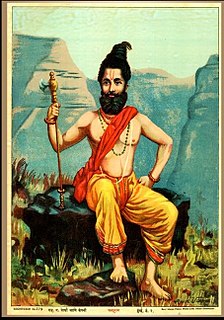
Parashurama is the sixth avatar of Vishnu in Hinduism and he is one of the chiranjeevis who will appear at the end of the Kali yuga to be the guru of Vishnu's tenth and last avatar Kalki. He carried a number of traits, which included aggression, warfare and valor; also, serenity, prudence and patience. Like other incarnations of Vishnu, he was foretold to appear at a time when overwhelming evil prevailed on the earth.The Kshatriya class, with weapons and power, had begun to abuse their power, take what belonged to others by force and tyrannize people. Parashurama corrects the cosmic equilibrium by destroying these Kshatriya warriors. Parashurama is also the Guru of Bhishma, Dronacharya, and Karna. He is also referred to as Rama Jamadagnya, Rama Bhargava and Veerarama in some Hindu texts.
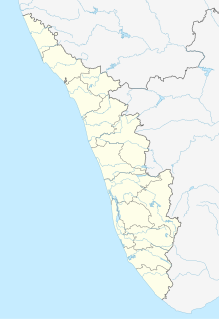
Kaduthuruthy is a town in Kottayam District in the state of Kerala, India

Kadappattoor is a small village on the banks of Meenachil river near Pala in Kottayam district of Kerala. Kadappattoor, is located 30 km east of Kottayam. The village life is centered on the Shiva Kadappattoor Mahadeva Temple The population consists of Hindus and Christians.

Anandavalleeswaram Sri Mahadevar Temple in Kollam city is one of the ancient Hindu temples in Kerala, India. Lord Siva and Goddess Anandavally are the main deities of the temple. According to folklore, sage Parashurama has installed the idol of Lord Shiva. The temple is a part of the 108 famous Shiva temples in Kerala. It is located at Anandavalleeswaram, a major neighborhood of Kollam city, that comes to the west side of Kollam Collectorate.

Ettumanoor Mahadeva temple is an ancient Shiva temple in Kottayam, Kerala, India. Temple tradition has it that the Pandavas and the sage Vyasa had worshipped at this temple. The name of the place has its origin from the word manoor, which means "the land of deer." The temple is one of the major Shiva temples in Kerala, along with Vaikom Temple, Chengannur Mahadeva Temple, Kaduthruthy Mahadeva Temple, Ernakulam Shiva Temple, Vazhappally Maha Siva Temple and Vadakkunathan temple.

Ernakulam Shiva Temple, also known as Ernakulathappan Temple is one of the major temples of Kerala, located in heart of Ernakulam, Kochi. The temple, dedicated to Lord Shiva, is considered as the city temple, with the presiding deity as the protector of the city, as per local Hindu faiths and traditions. As per the common practice in Kerala, the deity is reverently called Ernakulathappan, which means Lord of Ernakulam. The temple is located within the Durbar Hall Ground. The temple history itself has deep association with history of the city and was one of the 7 royal temples of Kochi Maharajas. The temple is now under administration of Cochin Devaswam Board. The temple in its current form was built under active patronage of Diwan Sri Edakkunni Sankara Warrier in year 1846 and raised it level of a Royal temple in the Kochi Kingdom. The temple is built on 1-acre (4,000 m2) land. The temple is one of the major Shiva temples in Kerala counted along with the Ettumanoor Mahadevar Temple, Kaduthruthy Mahadeva Temple, Vaikom Temple, Chengannur Mahadeva Temple and Vadakkunathan temple.

Vazhappally Maha Siva Temple is a Hindu temple located in Vazhappally near Changanassery in Kottayam district in the Indian state of Kerala. The temple is administered by the Travancore Devaswom Board. The temple is believed to be constructed by the first Chera king of Kodungallur. The legends suggest that the installation of the idol of god Mahadeva (Shiva) was performed by Parasurama himself. This temple is one among the 108 Shiva temples established by Parasurama. It is one of the few temples in Kerala where two nalambalams and two flag-masts are dedicated. The temple, a Grama Kshetra, also contains some seventeenth century wood carvings depicting figurines from epics. A Vattezhuttu inscription on the northern part of the base of the cultural shrine indicates that the repairs were completed in Kollam Era 840 (1665 AD).

Thuravoor is a gram panchayat in the Pattanakkad Block of Cherthala Taluk of the Alappuzha District, State of Kerala, India. It comes under Aroor Assembly constituency. Thuravoor lies exactly between Kochi and Alappuzha. A four lane National Highway 47 passes through the village, which along with a railway station gives it excellent connectivity with the remainder of the state. Thuravoor is famous for the Narasimha Swamy temple which is dedicated to the fourth incarnation (avatara) of Vishnu, the Narasimha. The temple has two main deities, the Vadakkanappan and the Tekkanappan, which is rare among the temples of Kerala.
Kaduthuruthy Mahadeva Temple at Kaduthuruthy is situated in Kottayam District of Kerala. The presiding deity is Shiva facing east. The temple is one of the major Shiva temples in Kerala counted along with the Ettumanoor Mahadevar Temple, Chengannur Mahadeva Temple, Vaikom Temple, Ernakulam Shiva Temple and Vadakkunathan temple.

Kandiyoor Sree Mahadeva Temple is an ancient Shiva temple situated in Kandiyoor near Mavelikkara on the banks of Achankovil river. Kandiyoor was once the capital of the Odanadu kingdom. The temple and region are related to the history of ancient Buddhism in Kerala. Kandiyoor Sree Mahadeva Temple is 1 kilometre (0.62 mi) west of Mavelikara town north of State Highway 6. It is spread across an area of 7.5 acres (3.0 ha).

Mathur Shiva Temple is a Hindu temple located in Kunnamkulam of Thrissur District of India. It is believed that the Siva linga is Rudrakshasila which is irregular in shape, red in colour and is untouched by the human sculptor. The presiding deity of the temple is Shiva located in main Sanctum Sanctorum, facing West and Lord Parvathi located in same Sanctum Sanatorium, facing East. According to folklore, sage Parashurama has installed the idol. The temple is a part of the 108 famous Shiva temples in Kerala.
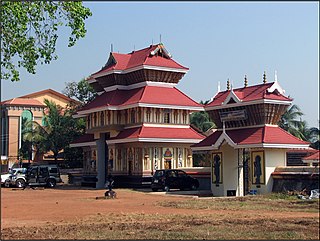
Muthuvara Mahadeva Temple is a Shiv temple located in Muthuvara, Thrissur city of India. Parashurama, the sixth avatar of Vishnu has installed the idol. The idol is in rowdrabhavam. The temple have one sreekovil for Shiv and another one for Vishnu.

Chengannur Mahadeva Temple is a prominent Hindu temple, dedicated to Shiva and located in the town of Chengannur in the South Indian state of Kerala. The temple is one of the major Shiva temples in Kerala counted along with the Ettumanoor Mahadevar Temple, Kaduthruthy Mahadeva Temple, Vaikom Temple, Ernakulam Shiva Temple and Vadakkunathan temple. There are shrines for Ganesha, Dakshinamurthy, Subramanya, Sastha, Krishna, Nilagriva, Sthalisha, Hanuman, Ganga and Serpent deities inside and outside the temple complex.

Tirunettur Mahadeva Temple is located at Vyttila village in Ernakulam district. The temple have two main deities, Sri Parameswara and Maha Vishnu. Deities having separate temple complex; Lord Sri Parameswara in the form of Sri Rudra and Maha Vishnu in the form of Vaikundeswara. Both deities are facing east. It is believed that Shiva temple is one of the 108 Shiva temples of Kerala and is installed by sage Parasurama dedicated to Lord Shiva.
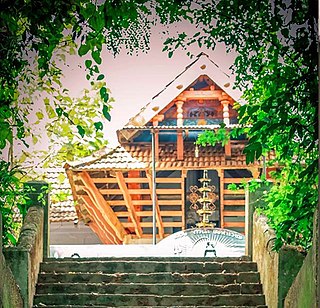
Thrikkunnathu Mahadeva Temple, located in Kanjany in Thrissur district of Kerala. This temple is a classic example of the Dravidian style of architecture. Thrikkunnathu Mahadeva Temple is situated near to Karuvannur River and the presiding deity of the temple is Shiva, located in main sanctum sanatorium facing east. According to folklore, sage Parasurama has installed the idol. The temple is a part of the 108 famous Shiva temples in Kerala.

Perakam Mahadeva Temple is an ancient Hindu temple dedicated to Lord Shiva is situated at Perakam village of Thrissur District in Kerala state in India. According to folklore, sage Parashurama has installed the idol of Lord Shiva in Perakam village. The temple is a part of the 108 famous Shiva temples in Kerala and described in shivalaya sothram.

Cheranalloor Mahadeva Temple is an ancient Hindu temple dedicated to Shiva is situated on the banks of the Periyar river at Kalady of Ernakulam District in Kerala state in India. The Cheranalloor Mahadeva Temple is one of the important temples in Cochin Kingdom. According to folklore, sage Parashurama has installed the idol of Shiva in the Treta Yuga. The temple is a part of the 108 Shiva Temples in Kerala.
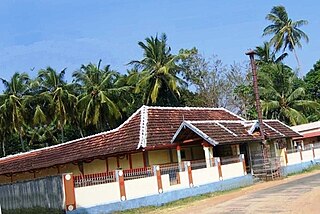
Pokkunny Siva Temple is an ancient Hindu temple dedicated to Lord Shiva is situated at Vadavannur village of Alathur of Palakkad district in Kerala state in India. The temple is a part of the 108 famous Shiva temples in Kerala. The temple is dedicated to Lord Shiva. Legend has it that Parasurama was installed Shiva Linga at the pond (Perumkulam) in Alathur. The temple was built by the King of Kollamkodu kingdom.

Thrippalur Mahadeva Temple is an ancient Hindu temple dedicated to Lord Shiva, Krishna and Narasimha is situated on the banks of the Gayatri river at Alathur of Palakkad District in Kerala state in India. References to this temple are found in many of the classics of Malayalam Literature. According to folklore, sage Parashurama has installed the idol of Lord Shiva in the Treta Yuga. The temple is a part of the 108 famous Shiva temples in Kerala. The temple is dedicated to Lord Narasimha and Lord Krishna in addition to Lord Shiva. Therefore, the Saiva-Vaishnava glow is a holy abode.
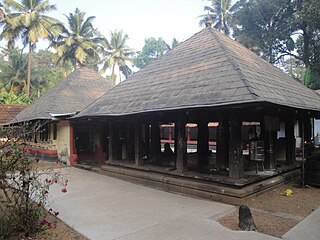
Thiruvatta Mahadeva Temple is an ancient Hindu temple dedicated to Lord Shiva is situated on the banks of the Manimalayar (river) in Thiruvalla of Pathanamthitta District in Kerala state in India. References to this temple is found in Vazhappally inscription relates to the rule of Kodungallur Chera king Rama Rajasekhara and temple at Vazhappally. It is the earliest available epigraphical record mentioning a Kodungallur Chera king and written in Malayalam language. According to folklore, sage Parashurama has installed the idol of Lord Shiva in the Treta Yuga. The temple is a part of the 108 famous Shiva temples in Kerala.






























